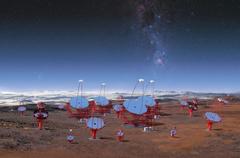Illustration of all three classes of the 99 telescopes planned for the southern hemisphere at ESO's Paranal Observatory, as viewed from the centre of the array. This rendering is not an accurate representation of the final array layout, but it illustrates the enormous scale of the CTA telescopes and the array itself. Credit: Credit: CTAO/M-A. Besel/IAC (G.P. Diaz)/ESO (CC BY-NC-ND 2.0) [Source]
The signing of the final agreements has paved the way for the start of construction of the southern hemisphere Cherenkov Telescope Array CTA in Chile. In the international project, DESY is responsible for the development and the construction of CTA's medium-sized telescopes, the “workhorses” among the three different CTA telescope types. Also, DESY will host the CTA's Science Data Management Centre at its Zeuthen site.
A total of three agreements were signed in Santiago: between the Chilean government and European Southern Observatory ESO, partner of the CTA; between ESO and CTA Observatory; and between CTA Observatory and Chile‘s Comisión Nacional de Investigación Científica y Tecnológica (CONICYT) or National Commission for Scientific and Technological Research. With these three agreements in place, the CTA Observatory company will be able to begin construction on the southern site near ESO’s Paranal Observatory in Chile. The hosting agreement with the Instituto de Astrofísica de Canarias (IAC) is already in place to host CTA’s northern hemisphere array at the Observatorio del Roque de los Muchachos in La Palma, Spain. Construction on both the northern and southern arrays is expected to begin in 2020.
CTA will be the next generation ground-based instrument in the detection of gamma rays, which are very high-energy electromagnetic radiation emitted by the hottest and most powerful objects in the Universe — such as supermassive black holes, supernovae and possibly remnants of the Big Bang. To provide access to the whole sky, the CTA Observatory will have two sites, with 19 telescopes in the northern hemisphere and 99 in the southern hemisphere.
CTA’s southern site is only 11 kilometres southeast of the location of the Very Large Telescope at ESO's Paranal Observatory in the Atacama Desert, and just 16 kilometres from the construction site of the upcoming Extremely Large Telescope. This is one of the driest and most isolated regions on Earth — an astronomical paradise. In addition to the ideal conditions for year-round observation, installing CTA at the Paranal Observatory brings the advantages of ESO’s expertise and infrastructure.
Current gamma-ray telescope arrays only consist of a handful of individual telescopes, but CTA — with its larger collecting area and wider sky coverage — will be the largest and most sensitive array of gamma-ray telescopes in the world, with unprecedented accuracy and 10 times more sensitive than existing instruments.
Although the Earth’s atmosphere prevents gamma rays from reaching the surface, CTA’s mirrors and high-speed cameras will capture the short-lived flashes of eerie blue Cherenkov radiation produced when gamma rays interact with the atmosphere. Detection of this Cherenkov light will allow the gamma ray to be traced back to its cosmic source.
The scientific scope of CTA is extremely broad: from understanding the role of relativistic cosmic particles to the search for dark matter. CTA will explore the extreme Universe, probing environments from the immediate neighbourhood of black holes to cosmic voids on the largest scales. It may even lead to brand new physics as it studies the nature of matter and forces beyond the Standard Model.
CTA is a global initiative to build the world’s largest and most sensitive high-energy gamma-ray observatory. More than 1,400 scientists and engineers from 31 countries across five continents (Armenia, Australia, Austria, Brazil, Bulgaria, Canada, Chile, Croatia, the Czech Republic, Finland, France, Germany, Greece, India, Ireland, Italy, Japan, Mexico, Namibia, the Netherlands, Norway, Poland, Slovenia, South Africa, Spain, Sweden, Switzerland, Thailand, the United Kingdom, the United States of America and Ukraine) and more than 200 research institutes are participating in the CTA project. CTA will be the foremost global observatory for very high-energy gamma-ray astronomy over the next decade and beyond and will be the first ground-based gamma-ray astronomy observatory open to the world-wide astronomical and particle physics communities.
http://astro.desy.de/gamma_astronomy/cta/index_eng.html








